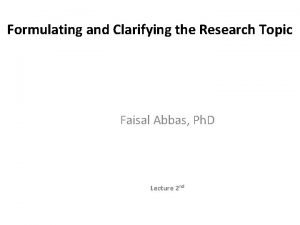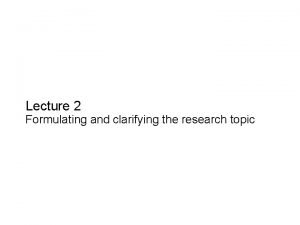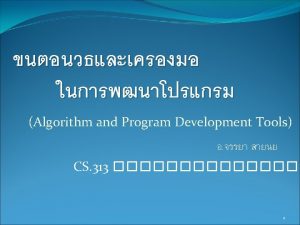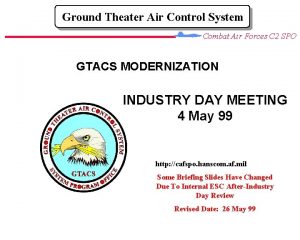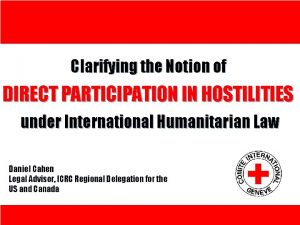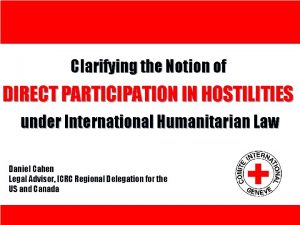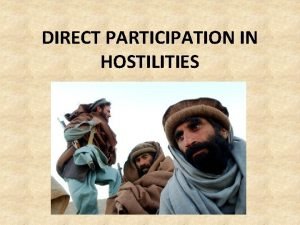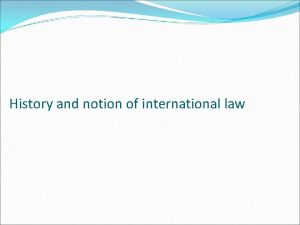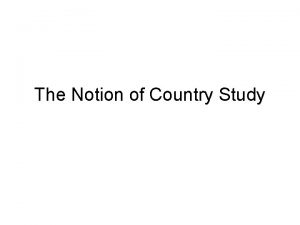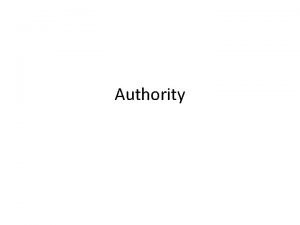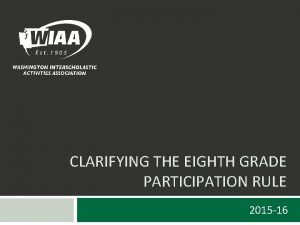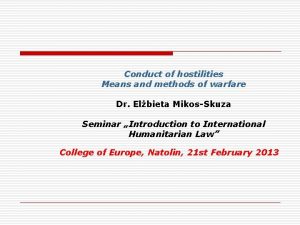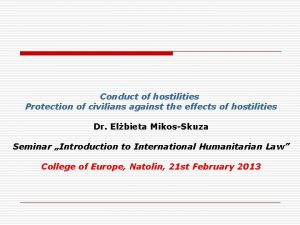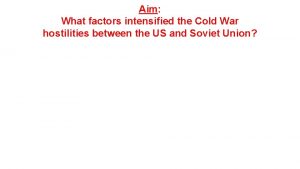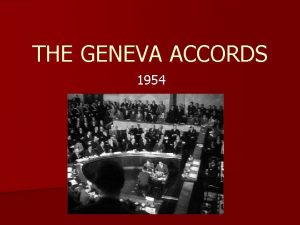Clarifying the Notion of DIRECT PARTICIPATION IN HOSTILITIES
















- Slides: 16

Clarifying the Notion of DIRECT PARTICIPATION IN HOSTILITIES under International Humanitarian Law Daniel Cahen Legal Advisor, ICRC Regional Delegation for the US and Canada

The Evolving Face of Warfare: • Predominantly non-international armed conflicts • Shift of battlefield into civilian population centers • Intermingling of armed actors with civilians • Civilian involvement in military operations • Outsourcing of traditional military functions • Armed actors in civilian clothing Ø Confusion in the distinction between legitimate targets and protected persons Ø Increased risk of erroneous & arbitrary attack

Military Necessity Basic Rules on. Humanity Lawful Targeting of Persons under IHL Principle of Distinction Persons not protected against direct attack Persons protected against direct attack Organized Fighting Forces belonging to the Parties to an Armed Conflict Civilians Directly Participating in Hostilities Armed Forces - Medical & Religious Personnel - Personnel hors de combat

Basic Rule on DPH: Civilians are protected against direct attack unless and for such time as they directly participate in hostilities. (Art. 51 [3] AP I; Art. 13 [3] AP II; Art. 3 [1] GC I to IV; Rule 6 CLS) Ø No definition in treaty law, state practice, jurisprudence Ø Lack of criteria for the distinction between peaceful civilians and civilians directly participating in hostilities Ø Lack of guidance as to applicability to hostile civilians of the paradigms of law enforcement and of hostilities

ICRC Clarification Process Ø Informal research process aiming to clarify the notion of 'direct participation in hostilities'. Ø Purpose: Enhancing the protection of the civilian population from erroneous or arbitrary targeting. Ø 5 Expert Meetings (2003 – 2008): 50 legal experts from a wide variety of backgrounds. Ø Publication (2009): ICRC's 'Interpretive Guidance on the Notion of Direct Participation in Hostilities under IHL'. Ø The Interpretive Guidance: § Does not change, but aims to clarify, the law. § Provides ICRC's recommendations on how existing IHL should be interpreted in contemporary armed conflicts. § Is not legally binding.

Questions to be Addressed: I. Concept of Civilian Determines the circle of persons who may not be directly attacked "unless and for such time as they take a direct part in hostilities" II. Concept of Direct Participation in Hostilities Determines the individual conduct which entails loss of civilian protection against direct attack III. Modalities of Suspension of Protection Determine: - Duration of loss of protection - Precautions and presumptions in situations of doubt - Restraints on force used against lawful military targets - Consequences of regaining civilian protection

I. Concept of Civilian under IHL: Generic: Civilians are those persons who are not members of the armed forces of a party to the conflict. International Armed Conflict: All persons who are not members of an organized armed force, group or unit under a command responsible to a party to the conflict and who are not participants in a levée en masse (Art. 50 [1], 43 [2] AP I). Non-International Armed Conflict: All persons who are not members of state armed forces, dissident armed forces or other organized armed groups under a command responsible to a party to the conflict (Art. 1 [1], 13 AP II).

I. Concept of Civilian under IHL: Generic: Civilians are those persons who are not members of organized armed forces or groups belonging to a state or non-state party to an armed conflict. (Arts 50, 43 AP I; Arts 1, 13 AP II; Art. 3 GC I-IV) Regular Armed Forces: Formal membership regulated in domestic law. Irregular Armed Groups: Functional membership based on continuous combat function (i. e. function involving DPH). Ø Private Contractors, Intelligence Services, etc. : Are civilians within the meaning of IHL, unless they assume continuous combat function for a party to an armed conflict. Ø Organized Criminals: The same criteria apply to terrorists, hostage-takers, drug-cartels and other organized criminals.

II. Direct Participation in Hostilities Basic Components: "Hostilities": Collective resort to means and methods of warfare between parties to an armed conflict. "Participation in" Hostilities: Individual involvement in collective hostilities between parties. "Direct" or "Indirect" Participation: Indicates intensity and degree of individual involvement. "Hostile Acts": Collective concept of "hostilities" corresponds to the sum total of all “hostile acts” carried out by individuals “directly participating” in hostilities.

II. Direct Participation in Hostilities Three Cumulative Elements: 1. Threshold of Harm: The act in question must be likely Ø to adversely affect the military operations or military capacity of a party to the conflict or, Ø to inflict death, injury or destruction on persons or objects protected against direct attack. 2. Direct Causation: There must be a direct causal link between the act in question and the harm likely to result: Ø from that act, or Ø from a concrete and coordinated military operation of which that act constitutes an integral part. 3. Belligerent The act must Nexus be designed : to directly cause the required threshold of harm in support of a party to the conflict and to the detriment of another.

II. Direct Participation in Hostilities Beginning and End of a Hostile Act A specific act amounting to “direct participation in hostilities” also includes: • Preparation of a specific act; • Deployments to the location of its execution; • Return from the location of its execution.

III. Modalities of Loss of Protection 1. Temporal Scope of Loss of Protection Civilians lose protection against direct attack for the duration of each specific act amounting to direct participation in hostilities. Members of organized armed forces or groups of a party to the conflict lose civilian protection for the duration of their membership.

III. Modalities of Loss of Protection 2. Precautions and Presumptions in Doubt All "feasible" precautions must be taken in determining whether: - a person is a civilian - a civilian is directly participating in hostilities In case of doubt, persons are presumed to be protected against direct attack.

III. Modalities of Loss of Protection 3. Restraints on Force in Direct Attack The means and methods, as well as kind and degree of force used against persons not entitled to protection against direct attack: 1. must not exceed what is actually necessary to accomplish a legitimate military purpose in the concrete circumstances, and 2. must not otherwise be prohibited by IHL or other branches of international law. Ø Source: Military necessity & humanity as expressed in national military manuals, Martens clause, prohibition of unnecessary suffering etc.

III. Modalities of Loss of Protection 4. Consequences of Regaining Civilian Protection Civilians who have ceased to directly participate in hostilities, as well as Members of organized armed groups who have disengaged from their combat function: 1. may no longer be directly attacked, but 2. remain subject to arrest and prosecution 3. DPH is not, as such, prohibited by IHL

Thank you for your attention! Questions? www. icrc. org
 Contoh strong entity dan weak entity
Contoh strong entity dan weak entity Formulating and clarifying the research topic
Formulating and clarifying the research topic Formulating and clarifying the research topic
Formulating and clarifying the research topic Formulating ideas
Formulating ideas Clarify reading strategy
Clarify reading strategy Clarifying roles and responsibilities
Clarifying roles and responsibilities Formulating and clarifying the research topic
Formulating and clarifying the research topic Secondary research question
Secondary research question Formulating and clarifying the research topic
Formulating and clarifying the research topic Spellers clarifying phrase
Spellers clarifying phrase Formulating and clarifying the research topic
Formulating and clarifying the research topic What is this font?
What is this font? Purposeful listening
Purposeful listening Notion of algorithm
Notion of algorithm Business plan zara
Business plan zara Theater air control system
Theater air control system Ciri ciri font sans serif
Ciri ciri font sans serif






